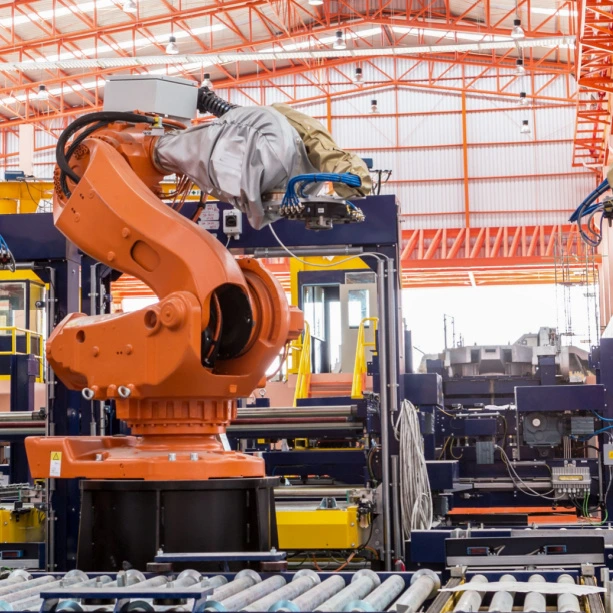Every manufacturer faces challenges. Sometimes a challenge comes in the form of a bottleneck; other times, it comes from missing tools. Over the years, IoT solutions have been developed to help manufacturers overcome their challenges, whatever those may be. Upon initial introduction, IoT asset tracking created fear and hesitation among manufacturers. But as time has gone on, the increased investment in IoT technology seems to indicate that those fears have lessened. What caused this shift from hesitance to confidence? Let’s break it down.
What is IoT Asset Tracking?
IoT asset tracking involves the communication between devices to determine the location of assets. The location this technology provides gives manufacturers visibility of their most important assets so they can improve operational efficiency. Asset tracking systems also provide data to manufacturers so they can better understand how productive their plant is. They can even gain insight into tool and equipment usage and when and where bottlenecks occur.
Increase Your ROI by Investing in AirFinder OnSite
- Low Cost. AirFinder OnSite XLE is a fraction of the cost of competitors' pricing.
- Long Battery Life. XLE lasts up to 7 years with hundreds of location updates daily.
- Increased Efficiency. Spend less time looking for assets, and more time being productive.
The History of IoT Asset Tracking
Before using IoT technology was an option, manufacturers first started tracking their assets by using spreadsheets. Since asset tracking didn’t exist yet, spreadsheets were the best solution, even if their use was often laborious and risked human error. When this method proved to be lacking, innovators took it upon themselves to automate asset tracking. Asset tracking software has since been developed and is continuing to evolve even today.
The first wave of automation came in the form of barcode scanners. Instead of manually writing down or typing in when a tool was signed in and out, the user just had to scan the barcode of the tool they were using. While this system did save time and money, further technological advancements have made apparent just how manual barcode scanners still are.
Automated asset tracking systems fully remove the human element of the tracking process. Tags are simply attached to the tools and equipment, and then automatically communicate with a gateway and access point to determine their location in real time. Employees don’t have to maintain records when they want to use a tool; location is automatically detected as it changes. And if they want to know the location of a tool that they need, they can simply look it up in the system to find its current location.
The Hesitance to Invest in an IoT Asset Tracking System
Since the introduction of IoT tracking devices, companies have been deterred from investing in the technology due to a variety of concerns.
Security Concerns
Cybersecurity risks automatically come with the investment in technology. The risks can be strategically managed, but they also increase if you don’t choose a system and provider wisely. Even so, many manufacturers have used these potential risks as an excuse not to invest.
There are ways to maximize security while choosing technology. One way is by choosing a technology that is IT-independent. If a system is independent of your existing company network, you have an extra layer of security. The breach of the system’s network does not mean your network will be breached; if your network is hacked, your system data is still protected.
High Costs
IoT technology comes with the connotation of being expensive. There are times when it is, but there are also times when the return you’ll receive is much greater than the price you pay for the technology. When you actually calculate how much money you spend to replace your tools or to have your employees search for your tools, you’ll often come to realize that investing now means you’ll be saving far more money in the future.
Job Security
When people think about using technology to make processes easier and faster, they often assume that the technology is intended to put them out of a job. No matter how common this misconception is, when it comes to asset tracking, it simply doesn’t reflect reality. Asset tracking doesn’t replace employees, it simply gives employees more time to do the job they were actually hired for, ultimately leading to higher production numbers and improved satisfaction.
The Motivation to Invest
Growing Complexity of Supply Chains
Supply chains have become increasingly complex over the years. With the rise of globalization and e-commerce, businesses are facing more challenges in managing their supply chains than ever before. This increased complexity has made it incredibly difficult for businesses to track their assets and manage their inventory effectively using a manual tracking process. IoT asset tracking offers a solution to these challenges by providing real-time visibility and data analytics. Businesses can track their assets in real time, making it easier to manage their manufacturing processes even as they become more complex in nature.
Better Customer Service
Customer service is a critical aspect of any business. When your manufacturing plant lacks visibility, production can’t be at the best it can possibly be. This can cause a number of problems beyond just productivity numbers. When production numbers are low, customer orders won’t be shipped in time, which often means that company reputation will take a hit. But with IoT tracking, production is optimized, leading to better delivery times and happy customers.
Data Analytics
Data analytics refers to the process of analyzing data to make better decisions. With an asset tracking IoT solution, manufacturers can collect data on the usage of their assets and use it to optimize their operations. This data can be used to identify usage trends, optimize inventory levels, and improve the supply chain. Awareness of this data can help businesses make informed decisions and improve their bottom line.
Cost Optimization
Cost optimization is essential for any manufacturer looking to remain competitive. IoT asset tracking can help businesses optimize costs by reducing waste and improving efficiency. By tracking assets in real time, manufacturers can also reduce the number of lost assets, which reduces both the time spent searching for them and the cost of replacing them. Real-time visibility also enables manufacturers to optimize their inventory levels, reducing the costs associated with holding excess inventory.
Which Commercial IoT Asset Tracking Solution Should You Use?
Our AirFinder OnSite solution is an innovative product that is revolutionizing the way manufacturing operations conduct business. With its advanced sensor technology and real-time tracking capabilities, AirFinder OnSite is helping manufacturers improve efficiency, increase productivity, and reduce costs. AirFinder OnSite has the ability to provide highly accurate location data in real time. This means that manufacturers can quickly and easily locate assets, leading to significant time and cost savings. Additionally, AirFinder OnSite can be customized to fit the specific needs of any business, making it a highly versatile and adaptable solution.
AirFinder OnSite has also proven to have an immense positive impact on employee morale. With its user-friendly IoT platform and intuitive design, AirFinder OnSite is easy to use and can help employees feel more in control of their work environment. This can lead to increased job satisfaction, improved performance, and a more positive work culture. Overall, AirFinder OnSite is an innovative and highly effective asset tracking solution helping manufacturers stay competitive in today's fast-paced digital world. By embracing this cutting-edge technology, businesses can improve efficiency, increase productivity, and create a positive working environment.
Conclusion
The demand for IoT asset tracking is increasing due to the prevailing need for real-time visibility. While there may still be hesitations and concerns about investing in this new technology, it's important to recognize the benefits that IoT asset tracking can bring. By embracing change and taking advantage of the many benefits of IoT asset tracking, businesses can position themselves to succeed for years to come.
Book a demo with our team to learn more about our solution and how it can benefit your manufacturing operations.





